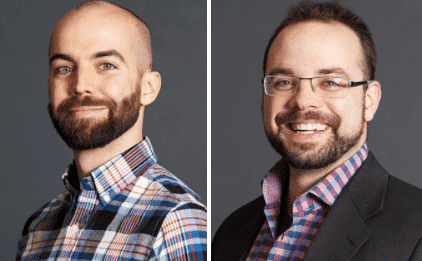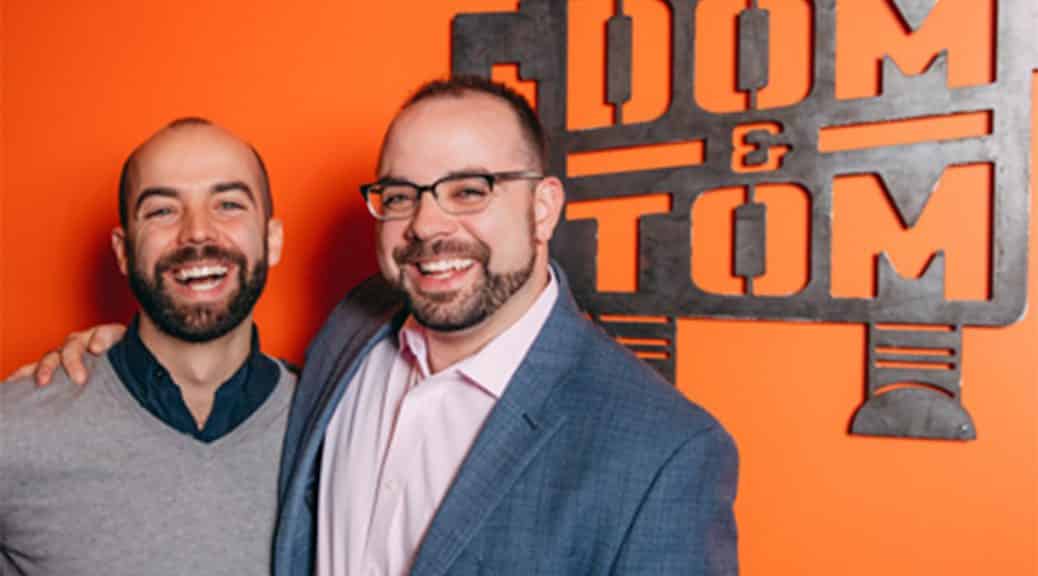Article
Strategy, Commitment and Family are Key at Mobile Agency Dom & Tom
September 1, 2017

The explosive growth of mobile has created opportunities for nearly every industry, and, of course, created new ones altogether. One of those new subcategories to emerge? Mobile app development, design and strategy agencies. If sheer numbers are any indication, like the 2.8 million apps on Android and 2.2 million apps on iOS, these agencies sure are thriving.
Dom & Tom is one of the top mobile agencies in the world. The company works with household names such as General Electric, Hearst, McDonald’s, Priceline and countless others to build industry-leading apps and digital experiences. But what makes Dom & Tom truly unique as a business outside of the outstanding products and commitment to excellence? It was founded by twin brothers, Dom and Tom Tancredi.

With collective experience spanning three decades, the dynamic family founders grew Dom & Tom from a small startup agency to one of the most well respected in the industry. Now with offices in Los Angeles, Chicago and New York and an Inc. Best Workplace award in hand, the brothers and leaders continue to approach their business more like a close-knit extended family instead of the stereotypical high-stakes world of agency.
We recently had a chance to catch up with both Dom and Tom and discussed everything from starting a business with your family, user-centered development approaches, the biggest mistakes brands make when building websites and apps, and so much more. Check out the full Q&A below!
Tell us about your background and about each of your roles at Dom & Tom.
Tom: I’ve got a bit of an unusual professional background in that I had five jobs in five different industries before starting Dom & Tom. I either quit or got fired from all of them. I worked in law, education, film production, television writing, and publishing and just didn’t feel like any were a great fit for me. Funny enough, I was trained in collections and used to call people for money all day, that sounds like a horrible skillset to have, but it taught me how to have thick skin.
At Dom & Tom, I am the Co-Founder and Chief Strategy Officer, and there are a few roles I fill at the company. On the client side, I work with businesses that are looking to add a technology component to their overall strategic vision. I help our clients figure out what their next steps are and how to get to launch.
Dom and I both play an equal role in elevating the voices of the people who work at the company. We are trying to promote up as much as we can, and having a background in 5 different industries has taught me what sort of culture works and what doesn’t. I think that is why we are so adamant about promoting the culture within our company.
Dom: I’m the CTO of Dom & Tom, as well as the CEO (we mutually decided since I’m two minutes older as a twin brother.) In the early days of the company, I acted as the Technical Lead and Developer on a majority of our initial projects, working with Tom to put together project plans, develop them within those timeframes, and spot-check the digital work we shipped. As the company grew, I became responsible for staffing teams with great talent, developing system architecture across multiple products, defining a project management methodology, and working with Tom to imbue our Vision, Values, and Mission with our growing team. I mainly champion the work we create; with great teams and a great process, backed by solid values.
Whose idea was it to start a company together?
Dom: Initially, we started out by rescuing our professional friend’s digital projects that were being sold a poor bill of goods by their existing development agencies or freelancers. There was so much wrong with their projects from receiving bad code to budgets being blown, designs not being matched or no defined requirements, etc. Tom and I had a reputation of being these dependable guys who wouldn’t quit until a project shipped. It was mostly a mutual decision to turn these rescue projects into a company, and I would say that Tom championed the vision and pushed for the incorporation of Dom & Tom.
How has your company evolved over the last 8+ years?
Tom: Initially, I think when Dom and I started the business we looked at it more as a small business, and we were only working on a few development projects. Dom even kept his job at the time. It was at a time when the economy was in a rough spot and people were frantically looking for trustworthy development partners. Here we are more than eight years later, and we have expanded our service offerings to include design, user experience, augmented reality and our mobile development has evolved.
Dom: We’ve grown from working in our Queens apartment to having offices in New York, Chicago, and Los Angeles with over 100 people working with us. We have taken on major Fortune 500 companies and brands that now serve as the bulk of our business.
Tom: We evolved to become a company that tilted forward in our attitude of what “good” is, and we now lead our clients in best practices, methodologies, and solution-sets.
Dom & Tom is known for producing high-quality apps with first-class user experiences. Why do you think your user-centered approach for app development is so effective?
Tom: We are process focused rather than product focused, which is why our user-centered approach works so well. Good intentions are not a plan, and hope is not a plan, but if businesses have a good plan and process around their product, then they can build anything great and receive consistently great results. Great products don’t come from chaos, and in truth, I’d rather have a better-trained team than someone who has superior skills.
Dom: Businesses, especially startups, fall into this trap of “beauty.” They think that creating timeless aesthetics is a product. But they’re putting the cart before the horse. We like to say, “We don’t conceptualize and build beautiful digital products. We build digital products people use that end up being beautiful.”
All consumers should be treated as individuals, and their choices in a digital product drive ongoing interaction and behavior, which empowers them to solve problems, spread joy from experience, or collaborate by sharing a skill. A user-centered approach seems innovative, but it’s an old remembrance. It’s the bond between three groups: those who are looking for something, those who have something to share, and those who bring them together and care for both. When users are listened to, and their signals are heard, the real value is delivered.
How important do you feel personalization is when it comes to mobile app experience design?
Tom: Simply put, if businesses want users to have personal accounts, then they have to have ahigh level of personalization. They have to understand their user because when they don’t, they create an app that is of a lesser quality that other apps will outshine. It’s not necessarily about building the app for certain demographics, but finding a way so that everyone can customize their own experience to a degree. When building an app, businesses have to tightly gather data, understand the things they need to adjust and make several iterations as they learn and grow.
Dom: I think it’s the next tidal wave. Personal everything. Who doesn’t want things to know who you are? Voice, A.I., your games, a site that gives you the movie you want or lists the product you’ve been hunting.
What do you think is the biggest mistake brands make when building websites and apps? Share a few pieces of advice for how to get primed for success.
Tom: The worst mistake I think a brand can make is not having a product owner to make decisions. Designing by committee is a disaster. Many people want to disseminate their decision-making, but someone has to have to vision and the ability to keep everyone in line with that vision.
Dom: “Try again. Fail again. Fail better,” said Samuel Beckett, an Irish avant-garde playwright, and novelist. Brands make mistakes. But they have to learn from their mistakes. The biggest mistake is not making any. Avoiding digital, hiding from new technologies that emerge, never repairing, updating or improving are also big missteps that a brand can make. Maybe it’s not listening to the users. Or maybe it’s the wrong feature at the wrong time. But a savvy brand can survive longer and learn more than a single person can by learning from its mistakes.
Also to reiterate what Tom said, having no leadership or product owner to make the decision that serves the end user.
How important is it to have a defined mobile strategy for clients?
Dom: It’s both vital, and elusive. Mobile could be the cornerstone of a product (e.g., Uber) or a side-effect of its core business (e.g., Amazon). Mobile isn’t a “thing” so much as it’s a destination. It’s a portal to a place that people connect either with themselves, others, or the universe. The mobile strategy of a brand has to align with the survivability in the market. Given more and more people are on a mobile device as an augmentation of their lifestyle, it is essential to consider how a brand might be on that platform and provide further value to the user.
Tom: It is imperative that a brand has a mobile strategy if they are launching a mobile product or a mobile component to their business. You frequently hear the words “mobile first,” and mobile should always be considered, but it doesn’t always have to be first. It is more important to have the mobile component defined, and brands should ask themselves how the mobile product can improve the lives of their users. What sort of journey do they want their users to take and how can they help them connect with their brand. Understanding what a user wants and needs will help with the product development and mobile strategy.
Do you have any best practices for mobile app development?
Dom & Tom:
Sure, plenty, and I would consider them hard-earned lessons.
- Talk to your users.
- Learn the methodology of digital product stewardship.
- Make sure to have an active advocate and product owner.
- Develop strong relationships with your product owner.
- Use a modern, sane technology on a platform that people are excited about.
- Think about the future.
- Go beyond design and development and launch.
- Don’t ever stop concepting, ideating and prototyping. You always have to improve. Pivot-or-persevere.
It comes down to a very simplistic analogy. No animal gives birth to an adult child. They are always babies, and babies need love, attention, support, and 101% of you. That’s really how mobile apps are. If you’re lucky and people are supportive, your baby could grow into an adolescent, and then a teenager, and then a real, value-adding member of society. But know who they are and learn how they grow, get help along the way, and give them the things they need to survive.
What should potential clients know before reaching out to your agency or other mobile app development shops?
Tom: For any business, whether they are a startup or an existing brand, they have to have a business plan that defines their future and outlines what they’re going to do and how they’re going to do it.
They must have the ability and time to participate in the development of their digital product. They need to have their internal roles & responsibilities defined. There has to be a budget in mind for themselves. If the budget is not decided, they could end up spending a lot of money.
They need to be aware of the time commitment and involvement, and they need the ability to learn a lot on the job. The development process will be part education and part collaboration. Collaboration is the nature of our client relationships, and we want our clients to know we intend to partner together for the success of the product.
Dom: Anyone reaching out to Dom & Tom, or any product agency for that matter, should be aware of what their central value proposition is for their users. They have to have some high-level understanding of their path-to-value (user flow, business transaction) and the overall cost of time, team, and effort to get that product launched.
You recently won an Inc. Best Workplaces Award, what would you say is the key to being a great place to work?
Tom: I think there are plenty of reasons why we were voted as a best workplace, but two stand out the most to me. First is our management style, which is setup to identify the chain of command and everyone’s responsibilities, and it permits autonomy and trust in the workplace. The simpler the chain of command, the better the work environment. When there is a lack of clarity and decision-making, things can get confusing. There has to be someone who is responsible, and team members need to know who they go to for clarity. We allow our team to self-manage their workload and explain how they are going to work, what they are going to work on, and what they may be blocked on.
Second is our culture; we have this great “in it together” mentality which applies when things are bad and when they are good. Everyone pulls their weight, and as a team, we work to find solutions together. I think it’s important for us to listen to our team members and be aware of the changes that we need to make. We certainly don’t have our heads in the clouds and understand there will always be things we can improve on.
Dom: A company is one of the most valuable innovations created in the history of civilization. It is a collection of individuals united in values, contributing their skills, resources, and passions to fulfill a shared purpose. We are a team of people and, more importantly, friends who share the same values, mission, and vision. Having a vision and supporting your team is important but the joy, passion, and values we carry with us make our company a home.
What do you value most about your culture and vision?
Tom: We really value relationships and understand how much they matter. Relationships extend beyond the product, and it is extremely important to us to foster lifelong relationships with not only our employees but also with our clients so that we can make meaningful and impactful decisions together.
Dom: The answer to this question is very similar to the previous one about why we’re a best workplace. Having a shared vision with our team and our clients is of the utmost value to Tom and me. We help our clients navigate and succeed in a world that’s only existed for three decades: digital. Architecture, law, and dentistry have been improved on for centuries, but the study and pursuit of excellence in the field of digital is still in its infancy. The team members at Dom & Tom explore and expand that universe, and we value every one of them.
The friends we’ve made over the years at Dom & Tom are people we consider our family. And as our Dad likes to say, “Pensere a tutta la famiglia” which means “Think of all the family.”
The State of Brand Loyalty in the U.S. in 2023
Related



